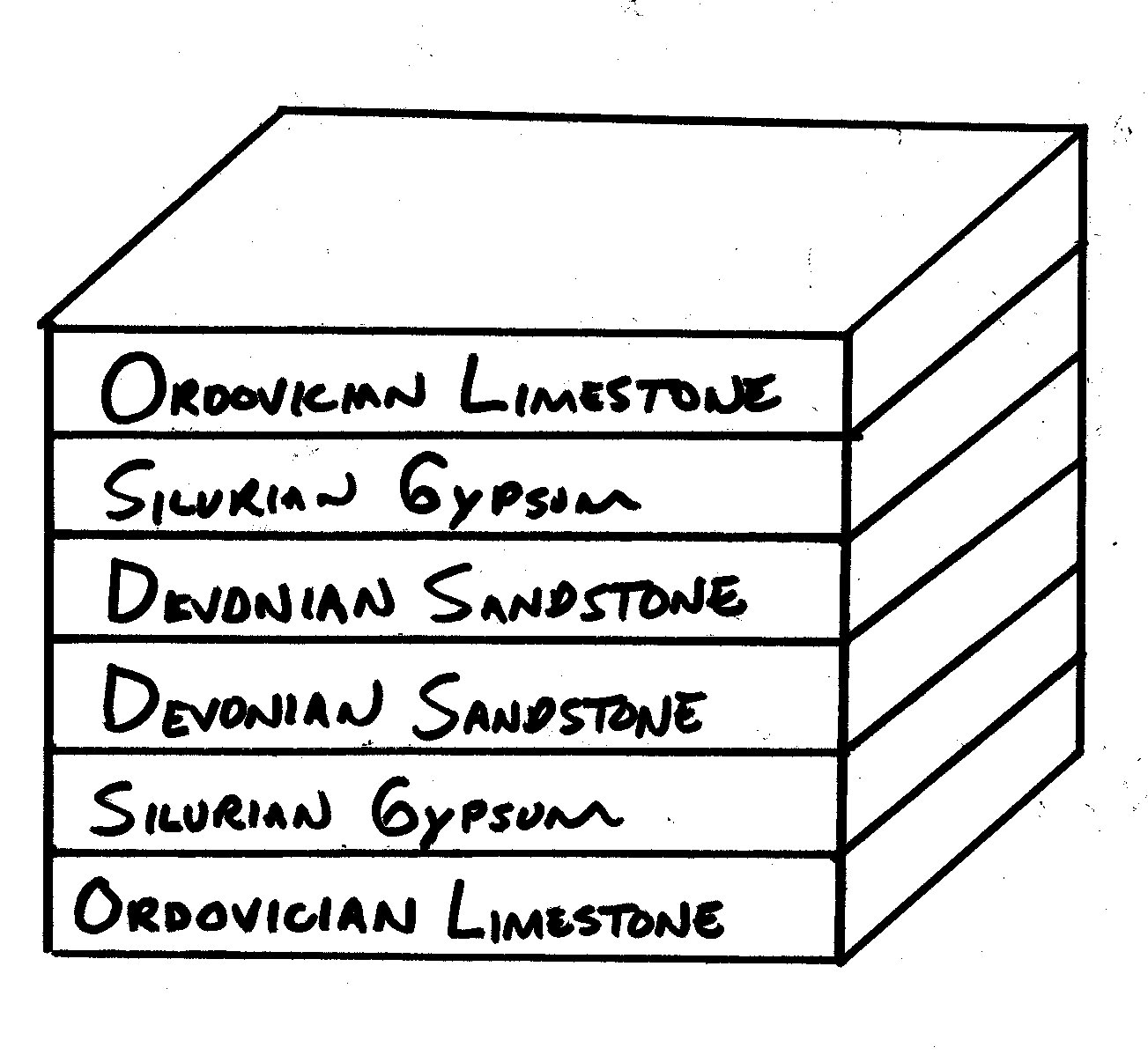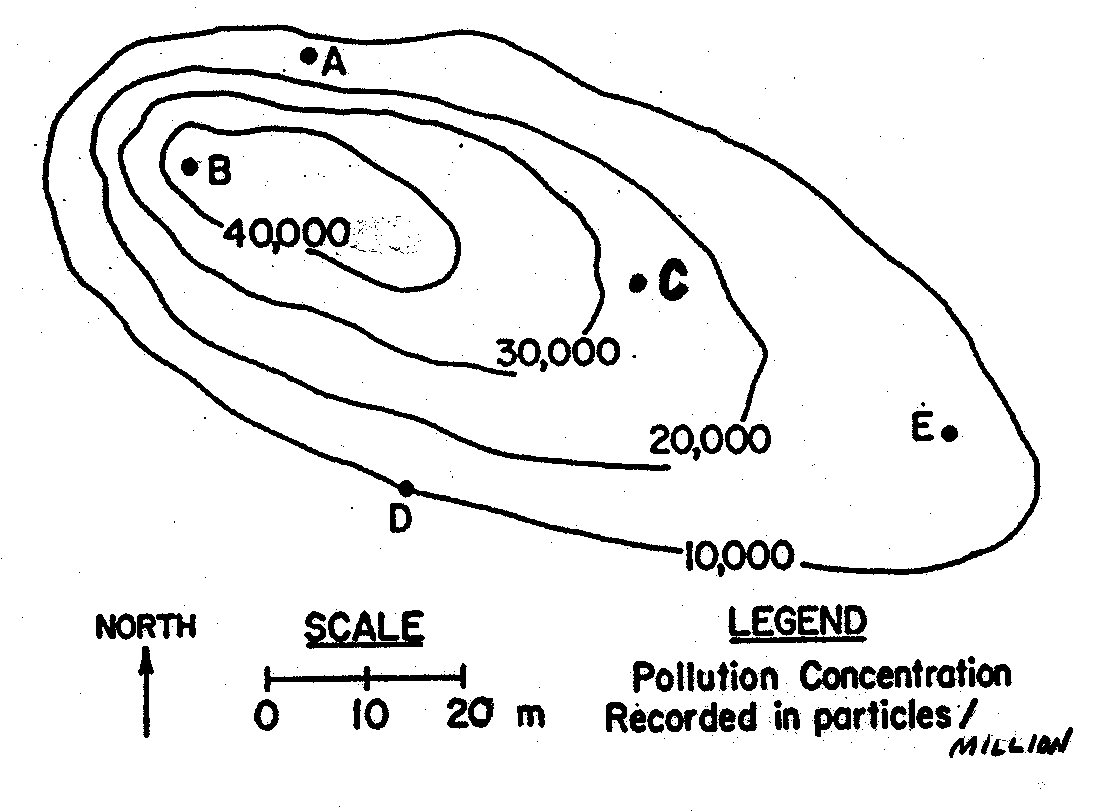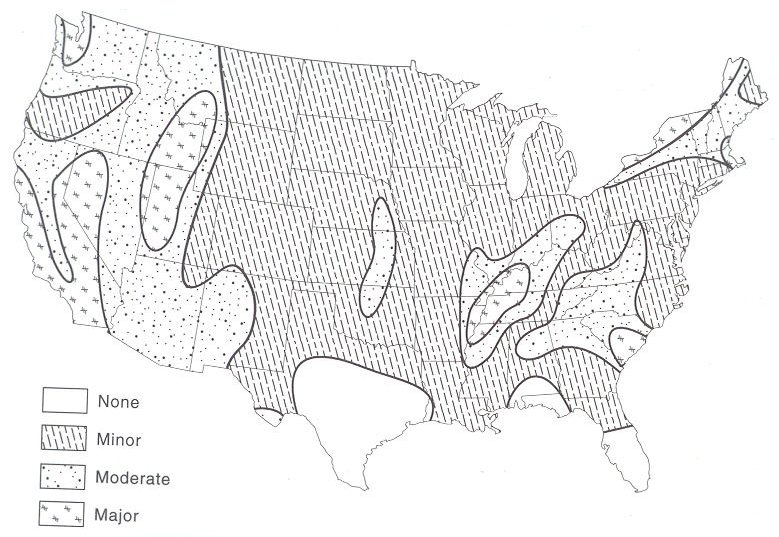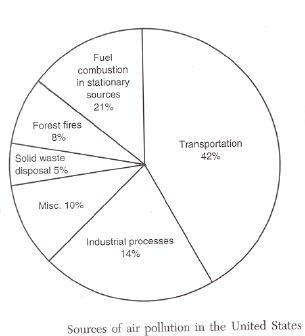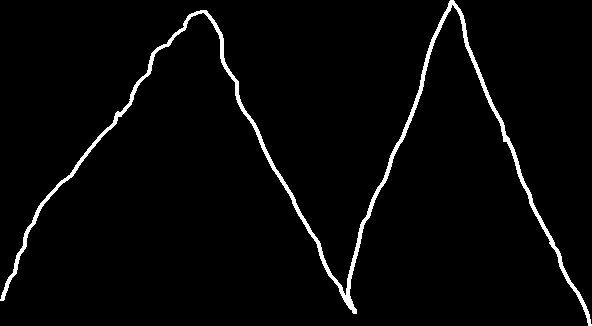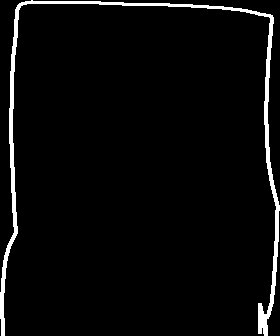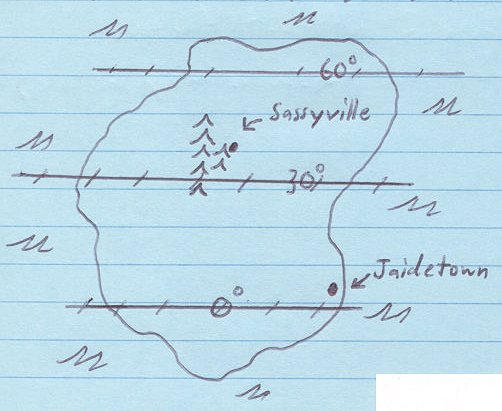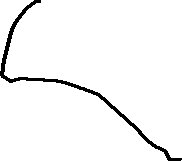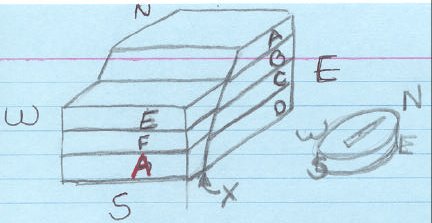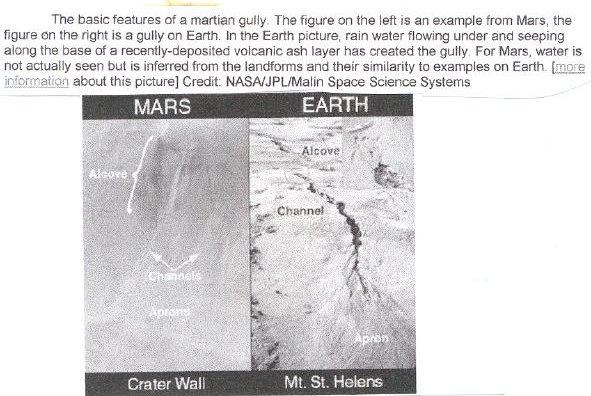500. The diagram below represents an outcrop of rocks found in Upstate New York. The relative age of
each rock layer is given.
Based on your knowledge of Earth Science and the
Earth Science Reference Tables
, what can be inferred
about this outcrop?
1)
faulting has occurred between the Devonian sandstone layers
2)
tectonic forces have overturned the sedimentary rock layers
3)
the youngest rock layer is on top
4)
the oldest rock layers are found in the middle
501.The diagram below represents a planet and a
comet traveling in their respective orbits around a star.
*COMET Z
*PLANET X
*
STAR
Compared to Planet X, Come
t Z has a:
1)
more elliptical orbit and a higher eccentricity
2)
more elliptical orbit and a lower eccentricity
3)
less elliptical orbit and a higher eccentricity
4)
less elliptical orbit and a lower eccentricity
502.Compared to the terrestrial planets Mercury,
Venus, Earth, and Mars, the Jovian planet Saturn is:
1)
larger in size and more dense
2)
larger in size and less dense
3)
larger in size and has a shorter period of revolution
4)
smaller in size and less dense
503.Which graph best illustrates the relationship betw
een atmospheric pressure and distance from the
center of the earth?
1)
2)
PRESSURE
PRESSURE
DISTANCE
DISTANCE
3)
4)
PRESSURE
PRESSURE
DISTAN CE
DISTANCE
504.The igneous intrusion in the diagram below was dated and found to be younger in age than the
surrounding rock layers. This finding supports the:
1)
principle of superposition
2)
principle of original horizontality
3)
principle of crosscutting relationships
4)
principle of contact metamorphism
505.The following processes require a certain amount of time to complete. List the sequence of events
in increasing order of time to complete.
A. radioactive decay of 10 grams
of carbon14 into 5 grams of nitrogen14
B. the period of revolution of Pluto
C. one complete moon phase cycle
D. period of rotation of Jupiter
1)
A, B, C, D
2)
B, A, C, D
3)
D, C, B, A
4)
D, C, A, B
506.Which graph best illustrates the relationship between clou
d cover and the amount of insolation that
reaches the earth's surface:
1)
2)
CLOUD
CLOUD
COVER
COVER
INSOLATION
INSOLATION
3)
4)
CLOUD
CLOUD
COVER
COVER
INSOLATION
INSOLATION
507.Ancient inland seas existed in the continental United States during the Paleozoic and Mesozoic
eras. As these seas warmed and evaporated, deposits of ________________ formed.
1)
shale and rhyolite
2)
rock sale and schist
3)
dolostone and gypsum
4)
fossil limestone and obsidian
508.An unknown extrusive igneous rock is composed of approximately 60% plagioclase feldspar, 30%
amphibole and 10% biotite. The unknown rock is most likely:
1)
diorite
2)
andesite
3)
pumice
4)
gabbro
509.Diamond and graphite are composed entirel
y of the element carbon. However, on Moh’s scale of
hardness, Diamond is rated 10 and graphite is rated 1. The most logical explanation for the
differences in hardness is that:
1)
diamond exhibits cleavage and graphite does not
2)
they have different internal crystal structures
3)
diamond streaks none to white and graphite streaks grayblack
4)
graphite has a metallic luster and diamond does not
Base your answers to questions 510511 on your knowledge of Earth Science and the groundwater
pollution field map shown below. The isolines represent concentrations of pollutants in parts per
million.
510.State the position on the map where the groundwater pollution was most likely spilled. [1]
Rubric:
Allow 1 point for
location B
511.State the compass directio
n in which the groundwater pollution is moving. [2]
Rubric:
Allow 2 points for
Southeast or SE
Allow 1 point for East or South
Base your answers to questions 512 and 513 on the diagram below which represents the decay rates
of four different radioactive isotopes.
512.Based on the graph, what is the halflife of isotope B in years
. [2]
Rubric
: Allow 2 points for
4.5 x 10
9
years or 4,500,000,000 years.
Allow 1 point for +/ 500,000 years.
513.State one reason why isotop
e A would be the best isotope to use for dating material that was less
than 500,000 years old. [1]
Rubric
: Allow 1
point for answers such as:
•
Isotope A has the shortest halflife
or
•
Isotope A decays at a faster rate than the other isotopes
514.The d
iagram below represents the inferred positions of landmasses from the Triassic Period to the
Tertiary Period.
State the compass direction in which North America migrated from the Triassic Period to the
Tertiary Period. [2]
Rubric
: Allow 2 points for
Northwest or NW
Allow 1 point for west or north only
515.Answer questions 13 based on the caption below.
China is experiencing an “Industrial Revolution” similar to that of the United States in the
Nineteenth Century. China has vast deposits of lowgrade, sulfurrich coal, which it plans to use to
help fuel, its economy in the 21
st
Century.
1) Explain how burning fossil fuels such as coal contributes to global warming. [1]
Rubric
: Allow 1
point for answers such as:
•
Burning fossil fuels
adds greenhouse gases to the atmosphere.
•
Some of the terrestrial (infrared) radiation is trapped by greenhouse gases causing
global temperatures to slowly rise.
2) Explain how acid rain will become an environmental issue for China in the 21
st
Century. [1]
Rubric:
Allow 1
point for answers such as:
•
The combustion of coal for energy causes the release of greenhouse gases such as
SO
2
and NO
2
. These gases combine with atmospheric moisture to form “acid rain”.
•
Plants and animals are affected by excessive amounts of acid rain.
3) List 2 “renewable” resources that are currently being used to generate electricity for human
needs. [2]
Rubric:
Allow 2 points for answers such as:
•
Wind, water,
hydrothermal, or solar energy
516.Refer to the diagram below to a
nswer questions 47. The diagram represents two different
landscapes found in the United States. The significant difference in appearance is attributed to
climate types.
4)
Based on the shape of the topography, describe the type of climate at Location
A. [1]
Rubric
: Allow 1
point for answers such as:
•
Location A is located in a humid climate because the landscape has gentle slopes
and a rounded appearance.
5) Based on the shape of the topography, describe the type of climate at Location B. [1]
Rubric:
Allow 1
point for answers such as:
•
Location B is located in an arid climate because the landscape has steep slopes and
an angular appearance.
6) What is the dominant type of weathering (chemical or mechanical) occurring at Location A and
why? [1]
Rubric:
Allow 1
point for answers such as:
•
Chemical weathering is the dominant type of weathering at Location A because the
rounded appearance of the landscape is caused by precipitation and chemical
reactions at the Earth’s surface.
7) What is the
dominant type of weathering (chemical or mechanical) occurring at Location B and
why? [1]
Rubric
: Allow 1
point for answers such as:
•
Mechanical weathering is the dominant type of weathering at Location B because
the angular appearance of the landscape is caused by frost action and extreme
heating and cooling of the Earth’s surface.
517. How do terrestrial planets differ from
Jovian planets?
1)
terrestrial planets are small and rocky;
Jovian planets are large and gaseous.
2)
terrestrial planets are large and rocky;
Jovian planets are small and gaseous.
3)
terrestrial planets are small and gaseous; ;
Jovian planets are large and rocky.
4)
terrestrial planets are large and gaseous;
Jovian planets are small and rocky.
518.How is water returned from the atmosphere to
the surface of the Earth during the hydrologic
(water) cycle?
1)
precipitation
2)
evaporation
3)
infiltration
4)
transpiration
519.Using a
psychrometer and a chart, which weather variable can be measured?
1)
temperature
2)
air pressure
3)
wind speed
4)
relative humidity
520.A student examines a sample of the sedimentary rock conglomerate. Compared to the age of the
rock, the age of the pebbles in the rock.
1)
are older
2)
are younger
3)
are the same age
4)
cannot be determined
521.How does the length of human existence on earth com
pare to the total length of geologic time?
1)
human existence is more than 60% of geologic time
2)
human existence is about 40% of geologic time
3)
human existence is about 20% of geologic time
4)
human existence is less than 1% of geologic time
522.The interior of
the earth is inferred to be layers differing in composition and state of matter.
This
inference was made by analyzing:
1)
ocean waves
2)
seismic waves
3)
light waves
4)
water waves
523.New ocean crust is continually formed along:
1)
deep ocean trenches
2)
transform faults
3)
midocean ridges
4)
subduction zones
524.Beaches, sandbars and barrier islands are characteristic of which agent of erosion?
1)
running water
2)
moving ice
3)
wave action
4)
mass movements
525.Base your answer to the question below on the diagram provided and y
our knowledge of earth
science.
How would the climate of location B differ from the climate of locations A and C?
B
Equator
A
C
1)
B has a warmer climate with little variation
2)
B has a warmer climate with a large variation
3)
B has a colder climate with a little variation
4)
B has a colder climate with a large variation
526.Some minerals form when atoms of existing minerals have been rearranged by conditions of high
heat and pressure. This type of mineral would be most likely observed in:
1)
volcanic rocks
2)
sedimentary rocks
3)
metamorphic rocks
4)
organic rocks
Minerals are formed inorganically by the process of crystallization. The shape of
minerals crystal
is useful in identifying a mineral.
527.In a complete sentence, state one way i
n which a mineral may crystallize.
Rubric:
Allow 1 credit for a sentence that includes any one:
•
cooling and/or solidification of magma/lava
•
precipitation from water
•
evaporation of water
•
chemical reactions
•
high heat and/or pressure
528.In a complete se
ntence, state one other physical or chemical property that can be used to identify a
mineral.
Rubric:
Allow 1 credit for a sentence that includes any one:
•
cleavage
i
hardness
•
fracture
i
streak
•
density
i
luster
•
reaction with acid
i
color
Base your answers to the questions below on the data table and your knowledge of Earth Science.
Latitude (°N)Observed Attitude of Polaris (°)
0
23
45
67
90
0
23
45
67
90
Construct a graph to illustrate the relationship between the observer’s latitude and the altitude
they observe Polaris.
Latitude (
°
N)
529.Construct an appropriate scale on
each
axis [1]
530.Plot the data and draw a line connecting the points [1]
Altitude of
polaris
(
°
)
531.In one or more complete sentences state the
relationship between the latitude of an observer and the
altitude they observe points.
Rubric for 529, 530, 531:
1 2 3 4 5 6 7 8 9 10
529. Allow 1 credit for an appropriate scale on each axis.
530. Allow 1 credit for plotting 4 of the 5 data points correctly
+ 2° and connecting all points in a
line.
531. Allow 1 credit for describing the correct relationship between the latitude of the observer
and the altitude they observe Polaris.
•
There is a direct relationship between the latitude of the observer and the altitude they
observe Polaris.
•
The higher the latitude the higher the altitude of Polaris.
•
As latitude increases the altitude of Polaris also increases.
Altitude of
polaris
(
°
)
Study the diagram and article provided.
532.State one difference in the ozone hole that you observe from the diagram between 1979 and 1998.
Write your answer in a complete sentence. [1]
533.If the trend were to continue for the next 50 years, explain how the incoming solar radiation
received in Antarctica might be different. Give a scientifically correct reason for your prediction.
[2]
Rubric
:
532.Allow 1 point for any observable diff
erence:
•
The size of the ozone hole has increased
•
The depth of the ozone hole has increased
•
The ozone hole is deeper in 1998
533.Allow 1 point for the incoming solar radiation would include
more
ultraviolet
wavelengths.
Allow 1 point for any valid scient
ific reason.
•
Ozone absorbs ultraviolet radiation, therefore if there’s a hole in the ozone more
ultraviolet radiation will be part of the incoming solar radiation.
534.An earth science student is studying the apparent motion of the sun in class. The t
eacher comments
on how an object’s shadow length changes from sunrise to sunset due to sun’s apparent motion.
The student wants to observe and investigate this relationship. Design an experiment the student
might conduct. Include these elements in your response:
•
identify the materials used [1]
•
describe a procedure that could be used.
use complete sentences. [2]
•
construct a data chart that could be used to collect the data. [2]
Rubric:
Allow 1 point for list that includes:
•
any object
•
clock or watch
Allow 2 points for a clearly described procedure that could be used to show the pattern.
•
measure the objects shadow every hour from sunrise to sunset
Allow only 1 point if complete sentences are not used.
Allow 2 points for any kind of chart that ha
s spaces for time of day and length of shadow.
Time
(hrs)
Length
(m)
Time
(hrs)
7
am
8
am
9
am
10
am
11
am
12
pm
1
pm
2
pm
3
pm
4
pm
5
pm
6
pm
7
pm
7 am
Length
8 am
Of
9 am
shadow
10 am
11 am
12
pm
1
pm
2
pm
3
pm
4
pm
5
pm
6
pm
7
pm
535.The orbits of which pair of planets in our solar sy
stem
are most nearly the same shape?
1)
Jupiter and Uranus
2)
Venus and Earth
3)
Saturn and Pluto
4)
Mercury and Mars
536.Which motion best explains why certain constellations are seen only during the winter?
1)
Earth’s revolution
2)
Earth’s rotation
3)
Sun’s rotation
4)
Galactic rotation
537.By which process is water transferred from the atmosphere to the Earth’s surface?
1)
precipitation
2)
infiltration
3)
evaporation
4)
transpiration
538.The breathable oxygen in Earth’s atmosphere resulted from which phenomenon?
1)
organic activity
2)
meteorite impacts
3)
volcanic activity
4)
lightning
539.Which instrument is used to measure a weather variable?
1)
psychrometer
2)
seismometer
3)
hydrometer
4)
gravinometer
540.Which phenomenon causes the earth’s
lithospheric plates to move?
1)
convection currents in the mantle
2)
ocean currents
3)
rotation of the earth
4)
gravitational pull of the moon
541.What must be added to weathered rock material in order to produce soil?
1)
organic material
2)
minerals
3)
water
4)
sand, silt, and clay
542.By which process have humans noticeabl
y altered climates?
1)
deforestation
2)
farming
3)
exploration of polar regions
4)
shipping by ocean
543. Which property of a mineral sample is directly related to the arrangement of its atoms?
1)
hardness
2)
color
3)
volume
4)
luster
544.Which could result in the precip
itation of a mineral from water?
1)
chemical reaction
2)
magmatic crystallization
3)
extreme pressure
4)
increased relative humidity
Use the diagram below and the “Earth Science Reference Tables” to answer questions 545 and 546:
545.Name the intrusive igneous
rock
, which would be the
last
to crystallize from magma.
______________ (
one credit for stating “granite”)
546.The “scheme for igneous rock identification” found in the earth science reference tables indicates
that extrusive rocks containing only
ovivine and pyroxene are “rare”. Explain in one or more
complete sentences why this is so.
One credit for a scientifically correct response. For example: “Olivine and Pyroxene have all ready
crystallized by the time magma reaches the surface”.
EARTHQUAKE RISK IN THE U.S.
547.From the map at left, determine the relative risk of earthquake in your area, and give one possible
reason explaining your level of risk. [2]
Rubric
: 1 credit for correctly
I.D.’ing area “none”, “minor”, “moderate”, “major”
1 credit for a scientifically correct reason; ex. “
presence of faults”
548.
How might the total amount of air pollution due to transportation be reduced in the future?
Rubric
: One credit for a logical/reasonable answer.
Ex: “drive less”, “car pool”, “develop cleaner transportation”, etc.
549. While walking through a cemetery, a student notices that some gravestones are more difficult to
read than others. The stones are evenly divided by rock type, half are
marble and half are granite.
He wonders if this has something to do with his ability to read them. He collects data, which is
shown in the table below. Assume all letters on the gravestones were originally carved to equal
depth, and that all the stones have remained in their original
position facing west.
STONE #
ROCK TYPE
DATE PLACED
LETTER DEPTH (mm)
1
2
3
4
5
6
Granite
Granite
Granite
Marble
Marble
Marble
1800
1850
1900
1800
1850
1900
1.6
1.9
2.5
0.9
1.1
1.8
1)
State the student’s hypothesis. [1]
2)
Identify the rock
type which weathered at a faster rate. [1]
3)
In a complete sentence, give one reason why the rocks appear to have
weatherated at different
rates. [1]
Rubric
:
1. Allow 1 credit for correct hypothesis
Ex: “Marble weathers faster than granite”
“Rocks we
ar at different rates, depending on type”
2.Allow 1 credit for stating “marble”
3. Allow 1 credit for a scientifically correct answer.
Ex: “Granite is harder than marble”
“Changes in the environment changed rates of weathering”
Use the following information to answer Questions 550 through 552.
550.Name a planet in our solar
system which is more likely than earth to have encounters like those
described in the article. [1]
551.In a complete sentence, explain why the planet above has a greate
r likelihood of such encounters.
[2]
552.Describe how earthasteroid collisions in prehistory may have affected life on earth. Include at
least one example of when this event may have occurred, and which life forms were affected. [3]
Rubric
: 1. Allow 1 credit for a scientifically correct answer: “Mars”, “Jupiter”, or any large planet.
2.Allow 1 credit for any valid answer.
Ex: “The planet is close to the asteroid belt”
“The planet has a strong gravitational pull”
Allow 1 credit if the given explanation applies to the planet selected.
3.Allow 1 credit for valid explanation of what an impact would do to life on earth.
Ex: “A collision would fill the sky with debris and kill plants by blocking the sun”.
Allow 1 credit for stating an era/period boundary.
Ex: “Mass extinction occurred at the end of Permian time”
“Life was largely killed off 65 million years ago”.
Allow 1 credit for including a group that likely became extinct due to an impact.
Ex: “Dinosaurs” or “Trilobites”
553.Index fossils are used to find:
1)
angular
unconformities
2)
correlations between rock layers
3)
halflife
4)
radioactive dates
554.The largest particles a stream can carry
is cobble sized. What is the probable velocity of this
stream?
1)
100 cm/sec
2)
150 cm/sec
3)
250 cm/sec
4)
450 cm/sec
555.The minimum number of seismic stations needed to locate the epicenter of an earthquake is?
1)
1
2)
2
3)
3
4)
4
556.Which one is
not
a natural agent of erosion?
1)
streams
2)
waveaction
3)
wind
4)
evaporation
557.If the rock dolomite is
put under extreme heat and pressure, without melting, what will it become
over time?
1)
Quartzite
2)
Schist
3)
Marble
4)
Rhyolite
558.An igneous rock produced by an underwater volcano will have a texture that is?
1)
coarse
2)
fine
3)
glassy
559.What is the “drivingforce
” behind all erosion?
1)
glacier
2)
stream
3)
wind
4)
gravity
560.The “load” of a stream refers to?
1)
how much water is passing a given point
2)
the slope of the stream
3)
the material a stream carries
4)
the number of tributaries
561.A student finds a red sandstone layer
while looking at rock strata. What is the most probable reason
this sandstone layer is red?
1)
oxidation
2)
hydration
3)
carbonation
4)
abrasion
562.The boundary found between the IndianAustralian Plate and the Antarctic Plate is a:
1)
transform plate boundary
2)
complex or uncertain
3)
divergent plate boundary
4)
convergent plate boundary
563.
rock
type
granite
1)
What type of landscape region is represented in the diagram?
2)
What is the most probable agent of erosion that formed the valley in the diagram?
Rubric
:
Allow 1 point for Question 1 for correct answer “mountain”.
Allow 1 point for Question 2 for correct answers “stream” or “water”
Layers have not been overturned. Use the diagram to answer Questions 564, 565, 566.
564.Order the different rock l
ayers in the geologic cross section above from oldest
to youngest.
___ ___ ___ ___ ___ ___ ___ ___ ___ ___
oldest
youngest
10 out of 10 = 3 points
08 out of 10 = 2 points
06 out of 10 = 1 point
565.State the
number that represents an igneous intrusion. [1]
566.What “principle” did you use to determine the age of these rocks? [1]
Rubric
: Maximum
score 5 points
1. 5
4
3
2
1
10
9
8
7
6
oldest
youngest
2. Allow 1 point for correct answer “10”.
3. Allow 1 point for correct answer “principle of superposition or relative dating or relative age or
any definition of superposition”.
567.The moon cycles through its ph
ases in approximately
one month. During this month observations
show that the moon “appears” to vary in diameter. In a paragraph, explain why this phenomenon of
varying diameter occurs. [3 points]
Rubric
: Allow 1 credit for an acceptable explanation for this phenomenon.
Allow 1 credit for scientifically correct terms in the explanation.
Ex: elliptical
perigee
agsogee
Allow 1 credit for complete sentences
The diagrams below show the same coastal area during the day and during the night. Use these
diagrams to answer Questions 568, 569 and 570.
568.Compare and
explain
the difference in heating and cooling rates of land and water. [1]
569.Explain
how
winds are formed by
discussing:
a. temperature differences [1]
b. density differences [1]
c. pressure gradient [1]
570.Label the diagrams with an arrow indicating the direction of the wind during the day and night.
Rubric
: 568.Allow 1 credit for an acceptable explanation of heating and cooling rates.
Ex: water has a
higher specific heat than land, conversely
water cools more slowly
water requires more heat energy than land to raise its temperature the same
amount
569. Allow a total of 3
credits for an acceptable explanation of how winds form (1 credit
for each correct part)
570. Allow 1 credit only if both diagrams are labeled correctly.
571.Which present weather symbol
does not
refer to a form of precipitation?
1)
.
2)
|
3)
∞
∞
4) *
572.A station in San Francisco receives P and S waves from
a recent earthquake. Determining the
difference in arrival ties between these two seismic waves can be used by itself to calculate:
_______.
1)
the epicenter distance
2)
the direction to the epicenter
3)
the focal distance
4)
the exact location of the epicenter
573.Our solar system includes the Sun, nine planets, their moons and:
1)
other stars
2)
a constellation
3)
asteroids and comets
4)
a galaxy
574.Refer to the diagram below. This shows the same tombstone at two different times in its history.
The year the picture is taken, along with the tombstone’s mass at that time is shown below each
picture.
R.I.P.
R.I.P.
1960
300 kg
1990
297.2 kg
The changing appearance and mass of the tombstone over
the 30 years most likely occurred due to:
1)
weathering and erosion
2)
radioactive decay
3)
glacial action
4)
an elevation increase
575.Dunite most likely formed by:
1)
quick cooling of lava at earth’s surface
2)
extreme pressure without melting
3)
dewatering, compacting, and
cementation
4)
slow solidification of magma inside the earth
576.Which of the following provides evidence of the earth’s rotation?
1)
the changing seasons
2)
the moon’s phases
3)
the sling
psycrometer
4)
the
Focault Pendulum
577.Pyroxene’s unique physical prope
rties were primarily determined by its:
1)
age
2)
size
3)
present temperature
4)
crystal structure and chemical composition
578.Humans have varying uses for certain rocks and minerals based on
their:
1)
location
2)
origin time
3)
physical and chemical properties
4)
size and shape alone
579. If the summer sun beat down equally on each of the following objects, which would likely feel the
most hot to the touch?
1)
a dull blacktop driveway
2)
a metal bike painted shiny yellow
3)
water in a swimming pool
4)
a white teeshirt
580.Refer t
o the diagram below and your knowledge of Earth Science.
Land Map
Key
If the sun appears to be directly overhead of location “A” at the present time, in how many hours
will it appear to be over location “B”?
1)
4 hours
2)
45 hours
3)
3 hours
4)
21 hours
Refer to the diagram below to answer Questions 581 and 582.
Sample
Sample
A
B
581.Sample “B” is an object with the exact composition, but half the volume and mass of Sample “A”.
If the densities of both samples were 4.5 g/cm
3
, describe and compare what would occur if both
were dropped into a vertical column of water at the same time. [1]
Rubric:
Allow 1 point for a scientifically correct
answer which states that both samples would drop
and Sample “A” would fall faster.
582.If a third sample has the exact density, mass and volume as Sample “A”, what characteristic must it
have for it to fall faster in a column of water? [1]
Rubric:
Allow 1 point for stating that the object must be, or be close to, a perfect sphere.
Refer to the diagram below and your knowledge of Earth Science to answer Questions 583 and 584.
583.What is the value (with units) for the volume of Sample A? [2]
Rubric:
Allow 2 points for a number within the range of 9.9 10.1 and (ml) for units.
Allow 1 point for correct units or #.
584.If the density of Sample “A” were 4.2g/ml, determine its mass. Include formula, substitutions,
answer and units. [3]
Rubric
: Allow 1 point for D = m/v or density = mass/volume.
Allow 1 point for correct substitution 4.2 = x/10 or # from 583.
Allow 1 point for correct answer and units 42g or calculated answers using # from 583.
585.Refer to the diagram below to answer both parts of Question 585. The drawing represents a
n
imaginary continent on the Earth’s surface.
A) Using complete sentences [1], identify 2 factors that will influence the climate in
Jaidetown and
explain
how both will affect it. [2]
B) Using complete sentences, identify 2
additional
factors (different from
A) that will influence
the climate of
Sassytown, and explain how both will affect it. [2]
Rubric:
A)Allow 2 points for A if the student correctly chose 2 factors (shown below) and
provided scientifically correct explanations as to how both affect the climate.
•
nearness to coastline ocean current modifies temperature
•
latitude closer to equator = high temperature
•
elevation closer to surface = warm, up in troposphere = cold
•
prevailing wind direction winds converge = wet
Allow 1 credit for 1 correct factor and explanation or 2 correct factors without
appropriate explanations.
B) Allow 2 credits if the student chose 2 different factors and explanations from those
in (A) additional answers may include:
•
nearness to center of landmass = large temperature range
•
leeward side of landmass = dry
•
wind direction = diverging = dry
Allow 1 credit if complete sentences throughout (A) and (B).
586.Refer to the diagram below to answer Question 586. Depicted is a new television station’s satellite,
recently boosted into an orbit around the Earth.
satellite *
Earth
* orbital path
A) Using complete sentences, describe and give reasons for the changes in velocity and
gravitational attraction as the satellite completes one revolution around the earth. [3]
B) Calculate the eccentricity of the satellite’s orbit. Be sure to include the formula. [2]
Rubric:
A)Allow 2 points for stating that the velocity and attraction will first increase and
then decrease due to becoming closer to then further from the center of gravity
(Earth).
Allow only 1 point if either the reason or pattern is wrong.
Allow 1 additional point if complete sentences were used.
B) Allow 2 points if the formula is written (e =
d.b.f
.
/l.m.a. or eccentricity = distance
between foci/length of major axis) and the answer is correct without units (e = 2)
Allow 1 point if only one of the two
are incorrect.
587.Plate movements are due to convection currents in which aspect of the earth?
1)
lithosphere
2)
athenosphere
3)
stiffer mantle
4)
inner core
588.Which of the following topographic maps includes a cliff?
1)
2)
3)
4)
589.Erosion by a stream could be increased by decreasing which of the following:
1)
discharge
2)
velocity
3)
gradient
4)
number of straight sections
590.Which of the following statements best describes a mineral?
1)
naturally occurring, inorganic elements and compounds
2)
materials produced from dead organisms
3)
solids formed from rapidly cooling magma
4)
naturally compacted and cemented rock material
591.Rocks with a distorted structure and contain alternate bands of light and dark minerals are classified
as which type of rock?
1)
chemical
2)
igneous
3)
metamorphic
4)
sedimentary
592.A finegrained igneous
rock which is
mafic in nature and contains olivine and pyroxene could be:
1)
obsidian
2)
gabbro
3)
basalt
4)
peridoite
593.In various parts of the earth like the mantle or atmosphere, convection currents form. What is the
cause of this motion?
1)
size differences
2)
density differences
3)
mass differences
4)
time differences
594.What do
Jovian planets have in common?
1)
small size and low density
2)
large size and high density
3)
medium size and no density
4)
large size and low density
595.Divisions of the geologic time scale are based on:
1)
radioactive dating
2)
fossil evidence
3)
climate changes
4)
superposition
596.In New York State what general direction do you need to face to observe Polaris?
1)
north
2)
south
3)
east
4)
west
A student is given several pieces of quartz and determined their density to be 2.8 g/cm
3
.
597.Use the previous student’s work and the formula D = m/v to create a data table for three other
pieces of quartz with a density of 2.8 g/cm
3
.
Mass g
Volume cm
3
Rubric:
2 points for 3 plausible answers
1 point for 1 or 2 plausible answers
Plausible if it fits:
St. mass
= 2.8
St.
vol
598.Scale the axis of the grid below according to your data in Question #597.
Rubric:
+1 for appropriate scale
Mass
Volume
599.Plot your data from Questions 597 on your graph and connect the points with a line.
Rubric:
+1 for a correct plot
+1 for the best line based on student plots
600.The structure labeled “X” is a ____________________
Rubric:
+1 correct answers
: fault
break in rock
601.On which side of the ridge (using cardinal directions) are the rocks the oldest? __________
Rubric:
+1 correct answer
: N or NE
602.Order the layers from oldest to youngest: __
__ __ __ __ __
Rubric:
+2 for 6 correct
+1 for 4 or 5 correct
In 1988 the Exxon Valdez ran aground 70 feet of the coast of Prince William Sound, Alaska. The
oil carried by the tanker spilled and eventually hit Alaska causing the 2
nd
largest oil spill on record.
603.State one reason that the oil slick spread predominantly towards the coast. [1]
Rubric:
1 point for science correct answer:
•
ocean currents
•
North Pacific currents
•
wave action
•
land breeze
604.If a similar spill were to occur off the coast o
f South Carolina, list one reason why the oil spill may
affect a wider geographic area.
Rubric:
1 point for ocean currents,
prevailing
westerlies
605.State two social implications resulting from Valdez:
Social
Science
•
pollution
•
death of sea life
•
drinking water
The basic features of a Martian gully. The figure on the left is an example from Mars; the figure on
the right is a gully on Earth. In the Earth picture, rainwater flowing under and seeping along the
base of a recently deposited volcanic ash layer has created the gully. For Mars, water is not
actually seen but is inferred from the landforms and their similarity to examples on Earth. Credit:
NASA/JPL/Malin Space Science Systems
Based on the above reading and the associated diagram, answer the following questions.
606.On your answer sheet sketch a crosssection of the channel which was carved by a stream. [1]
Rubric:
or
Answer 607 and 608 in complex sentences.
607.Make a statement about the dist
ribution of different sized sediments in the apron. [1]
Rubric:
sorted
horizontal sorted
narrow at mouth
wide at bottom
608.Why do scientists infer water was present on mars?
Rubric:
similar structure
both contain apron or channels
any scientifically correct answer
609.Which instruments are used to measure wind variables?
1)
barometer, thermometer
2)
psychrometer, anemometer
3)
wind vane, barometer
4)
anemometer, wind vane
610.Mineral crystals can be found in:
1)
igneous rocks but not in metamorphic nor sedimentary rocks
2)
igneous and metamorphic rocks but not in sedimentary rocks
3)
igneous, metamorphic and sedimentary rocks
4)
igneous and sedimentary rocks but not in metamorphic rocks
611.As measured by an observer on E
arth over the course of 2 years, the apparent diameter of the sun
will:
1)
decrease only
2)
increase only
3)
remain the same
4)
vary in a predictable manner
612.The following diagram compares the light spectrum of our sun, S1 and two stars located in other
galaxies. The spectra of S2 and S3 have been redshifted. This is evidence of which of the
following:
1)
stars differ in size
2)
the universe is expanding
3)
our galaxy contains billions of stars
4)
the universe contains billions of galaxies
Violet 4.2 5.4 5.8 6.2 Red
4.3 5.5 5.9 6.3
S1
4.5 S2 5.7 6.1 6.5
S3
Wavelengths X10
7
M
613. From the stars listed on the
Luminosity and Temperature of Stars
diagram, which star is closest to
the Earth?
1)
Alpha
Centauri
2)
Polaris
3)
Sun
4)
Sirius
614.Which list correctly orders planets from those with more circular orbits to those with less circular
orbits?
1)
Mercury, Earth, Jupiter, Uranus
2)
Mercury, Mars, Uranus, Jupiter
3)
Earth, Saturn, Mercury, Pluto
4)
Jupiter, Saturn, Neptune, Pluto
615.Equal masses of basalt, granite, iron, and lead were heated. Each sample increased 10ºC. The
temperature of which sample absorbed the
most heat energy?
1)
basalt
2)
granite
3)
iron
4)
lead
616.Which statement correctly indicates the general direction of flow of surface ocean currents in the
northern and southern hemispheres
.
1)
currents located in the northern hemisphere generally flow clockwise while those in the
southern hemisphere generally flow counterclockwise
2)
currents in both hemispheres generally flow clockwise
3)
currents in the northern hemisphere generally flow counterclockwise while those in the
southern hemisphere generally flow clockwise
4)
currents in both hemispheres generally flow counterclockwise
617.Which of the following sedimentary rocks, formed from precipitation,
must contain carbon?
1)
rock salt and rock gypsum
2)
rock gypsum and
dolostone
3)
dolostone and limestone
4)
limestone and rock salt
618.Which two elements are c
ommon to all of the minerals used to make glass?
1)
(K and Al) Potassium and Aluminum
2)
(Na and O) Sodium and oxygen
3)
(Si and O) Silicon and oxygen
4)
(Ca and
Si) Calcium and Silicon
Refer to the map below to answer Questions 619 and 620. The shaded portion of the map indicates
areas of night and the
unshaded portion indicates areas of daylight.
The shaded portion of the map indicates
ares of night and the
unshaded portion indicates areas of
daylight.
619.What day of the year is best r
epresented by the map?
Rubric:
Allow 1 point for the correct answers
December 21
; December 22.
620.During the next month state the general direction in terms of latitude that the top (peak) of the
lighted curve will move.
Rubric:
Allow 1 point for answer that indicates
increase, more north
or any combination or
single word that indicates either answer. Also # > 66º N.
Refer to the diagram below to answer Questions 621 and 622. Base your answers to the questions
on the cross section shown, and your knowledge of Earth science. Letters A through J represent
rock units. An unconformity is shown at letter X. A fault is shown at letter Y.
A student has made the following conclusion:
Rock Unit H was formed before Layer A, Fault Y and Unconformity X.
621.Do you support or reject his conclusion? Circle or underline your choice. [1]
Rubric:
Allow 1 point for correct answer
reject.
622.In one or more complete sentences, give evidence for your answer to 621.
Rubric:
Allow 1 point for any scientifically correct answer.
Allow 1 point for a complete
sentence supporting Question 621.
Ex: contact metamorphism shows A older than H
cross cutting relationship shows Y older than H
cross cutting relationship shows X older than H
Choose 2 stars listed on the Luminosity and Temperature of Stars diagram and answer the
following questions in one or more complete sentences.
Star 1: _____________
name
Star 2: _____________
name
623.Descri
be two differences between Star 1 and Star 2.
Rubric:
Allow 1 point for each correct answer (up to 2 points)
Ex: Polaris has
a luminosity greater than the sun.
Polaris is larger than the sun.
Polaris is bigger.
Rigel is hotter than Betelgeuse.
Rigel is blue/white and Betelgeuse is red.
Allow 0 points for answer
it is bigger.
624.Describe one similarity between Star 1 and Star 2.
Rubric:
Allow 1 point for each correct answer.
Ex: Polaris and the Sun
are both yellow.
Rigel and Betelgeuse are both
supergiants.
They are yellow.
They are
supergiants.
They are stars.
They have fusion.
Allow 0 points for the answer
yellow.
625.Using the table below and your knowledge of earth science, answer the followi
ng question in one or
more complete sentences.
The following table lists the agents of erosion along with descriptions of the sediments transported.
Running Water rounded, sorted
Glaciers
rounded, sorted melt water
angular, unsorted ice
Waves
rounded, sorted (?)
Wind
angular, frosted and pitted, small
Gravity
angular, unsorted, various sizes
A student is asked to identify the agent of erosion responsible for transporting sediments
found in a profile (field observation).
Indicate the agent(s) she eliminated based on an observation she made of one or more properties of the
sediment. [3]
You must include the observation and the agent eliminated for complete credit.
Rubric:
Allow 3 points for the following answers:
The sedi
ments were rounded therefore gravity was not the direct agent
of
erosion.
The sediments were sorted. Gravity could not be the agent of erosion.
The sediments were angular and unsorted. Running water could not be an
agent of erosion.
Allow 2 p
oints for the following answers:
Rounded sediments; not gravity
The sediments were rounded so it was water.
Allow 1 point for the following answers:
Gravity breaks rocks
Water
smooths rocks
The reason (agent) and observation should match
. The answer should be in
complete sentences. Take off one point for incomplete sentences. Give no
credit for scientifically incorrect answers. Ex: water, round, brown, can’t tell.
Back to top
